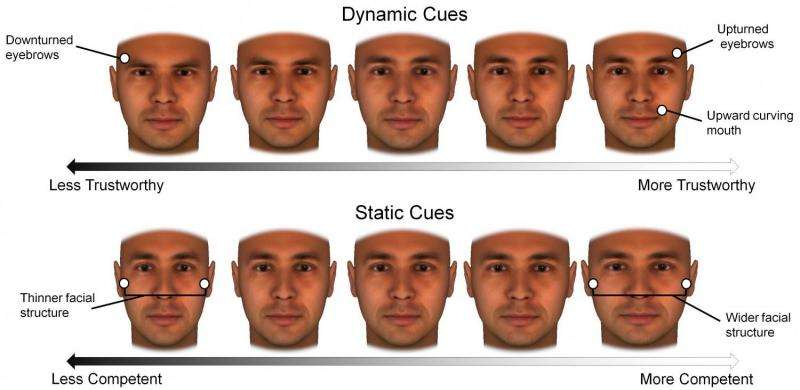Changing faces: We can look more trustworthy, but not more competent, research finds

We can alter our facial features in ways that make us look more trustworthy, but don't have the same ability to appear more competent, a team of New York University psychology researchers has found.
The study, which appears in the Personality and Social Psychology Bulletin, a SAGE journal, points to both the limits and potential we have in visually representing ourselves—from dating and career-networking sites to social media posts.
"Our findings show that facial cues conveying trustworthiness are malleable while facial cues conveying competence and ability are significantly less so," explains Jonathan Freeman, an assistant professor in NYU's Department of Psychology and the study's senior author. "The results suggest you can influence to an extent how trustworthy others perceive you to be in a facial photo, but perceptions of your competence or ability are considerably less able to be changed."
This distinction is due to the fact that judgments of trustworthiness are based on the face's dynamic musculature that can be slightly altered, with a neutral face resembling a happy expression likely to be seen as trustworthy and a neutral face resembling an angry expression likely to be seen as untrustworthy—even when faces aren't overtly smiling or angered. But perceptions of ability are drawn from a face's skeletal structure, which cannot be changed.
The study, whose other authors included Eric Hehman, an NYU post-doctoral researcher, and Jessica Flake, a doctoral candidate at the University of Connecticut, employed four experiments in which female and male subjects examined both photos and computer-generated images of adult males.
In the first, subjects looked at five distinct photos of 10 adult males of different ethnicities. Here, subjects' perceptions of trustworthiness of those pictured varied significantly, with happier-looking faces seen as more trustworthy and angrier-looking faces seen as more untrustworthy. However, the subjects' perceptions of ability, or competence, remained static—judgments were the same no matter which photo of the individual was being judged.
A second experiment replicated the first, but here, subjects evaluated 40 computer-generated faces that slowly evolved from "slightly happy" to "slightly angry," resulting in 20 different neutral instances of each individual face that slightly resembled a happy or angry expression. As with the first experiment, the subjects' perceptions of trustworthiness paralleled the emotion of the faces—the slightly happier the face appeared, the more likely he was seen to be trustworthy and vice versa for faces appearing slightly angrier. However, once again, perceptions of ability remained unchanged.
In the third experiment, the researchers implemented a real-world scenario. Here, subjects were shown an array of computer-generated faces and were asked one of two questions: which face they would choose to be their financial advisor (trustworthiness) and which they thought would be most likely to win a weightlifting competition (ability). Under this condition, the subjects were significantly more likely to choose as their financial advisor the faces resembling more positive, or happy, expressions. By contrast, emotional resemblance made no difference in subjects' selection of successful weightlifters; rather, they were more likely to choose faces with a particular form: those with a comparatively wider facial structure, which prior studies have associated with physical ability and testosterone.
In the fourth experiment, the researchers used a "reverse correlation" technique to uncover how subjects visually represent a trustworthy or competent face and how they visually represent the face of a trusted financial advisor or competent weightlifting champion. This technique allowed the researchers to determine which of all possible facial cues drive these distinct perceptions without specifying any cues in advance.
Here, resemblance to happy and angry expressions conveyed trustworthiness and was more prevalent in the faces of an imagined financial advisor while wider facial structure conveyed ability and was more prevalent in the faces of an imagined weightlifting champion.
These results confirmed the findings of the previous three experiments, further cementing the researchers' conclusion that perceptions of trustworthiness are malleable while those for competence or ability are immutable.





















